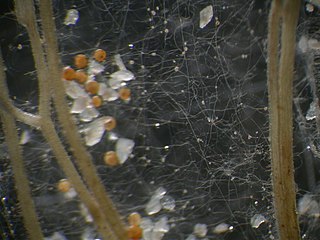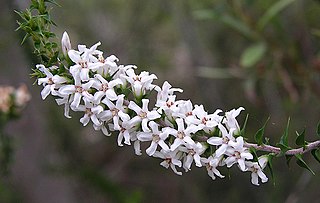
A mycorrhiza is a symbiotic association between a fungus and a plant. The term mycorrhiza refers to the role of the fungus in the plant's rhizosphere, its root system. Mycorrhizae play important roles in plant nutrition, soil biology, and soil chemistry.

An arbuscular mycorrhiza (AM) is a type of mycorrhiza in which the symbiont fungus penetrates the cortical cells of the roots of a vascular plant forming arbuscules. Arbuscular mycorrhiza is a type of endomycorrhiza along with ericoid mycorrhiza and orchid mycorrhiza .They are characterized by the formation of unique tree-like structures, the arbuscules. In addition, globular storage structures called vesicles are often encountered.

Glomeromycota are one of eight currently recognized divisions within the kingdom Fungi, with approximately 230 described species. Members of the Glomeromycota form arbuscular mycorrhizas (AMs) with the thalli of bryophytes and the roots of vascular land plants. Not all species have been shown to form AMs, and one, Geosiphon pyriformis, is known not to do so. Instead, it forms an endocytobiotic association with Nostoc cyanobacteria. The majority of evidence shows that the Glomeromycota are dependent on land plants for carbon and energy, but there is recent circumstantial evidence that some species may be able to lead an independent existence. The arbuscular mycorrhizal species are terrestrial and widely distributed in soils worldwide where they form symbioses with the roots of the majority of plant species (>80%). They can also be found in wetlands, including salt-marshes, and associated with epiphytic plants.
Glomus aggregatum is an arbuscular mycorrhizal fungus used as a soil inoculant in agriculture and horticulture. Like other species in this phylum it forms obligate symbioses with plant roots, where it obtains carbon (photosynthate) from the host plant in exchange for nutrients and other benefits.

Glomus is a genus of arbuscular mycorrhizal (AM) fungi, and all species form symbiotic relationships (mycorrhizae) with plant roots. Glomus is the largest genus of AM fungi, with ca. 85 species described, but is currently defined as non-monophyletic.

The ericoid mycorrhiza is a mutualistic relationship formed between members of the plant family Ericaceae and several lineages of mycorrhizal fungi. This symbiosis represents an important adaptation to acidic and nutrient poor soils that species in the Ericaceae typically inhabit, including boreal forests, bogs, and heathlands. Molecular clock estimates suggest that the symbiosis originated approximately 140 million years ago.

Glomerales is an order of symbiotic fungi within the phylum Glomeromycota.

Mucoromycotina is a subphylum of uncertain placement in Fungi. It was considered part of the phylum Zygomycota, but recent phylogenetic studies have shown that it was polyphyletic and thus split into several groups, it is now thought to be a paraphyletic grouping. Mucoromycotina is currently composed of 3 orders, 61 genera, and 325 species. Some common characteristics seen throughout the species include: development of coenocytic mycelium, saprotrophic lifestyles, and filamentous.
The Diversisporaceae are a family of fungi in the order Diversisporales. These fungi form arbuscular mycorrhiza and vesicles in roots.
The mycorrhizosphere is the region around a mycorrhizal fungus in which nutrients released from the fungus increase the microbial population and its activities. The roots of most terrestrial plants, including most crop plants and almost all woody plants, are colonized by mycorrhiza-forming symbiotic fungi. In this relationship, the plant roots are infected by a fungus, but the rest of the fungal mycelium continues to grow through the soil, digesting and absorbing nutrients and water and sharing these with its plant host. The fungus in turn benefits by receiving photosynthetic sugars from its host. The mycorrhizosphere consists of roots, hyphae of the directly connected mycorrhizal fungi, associated microorganisms, and the soil in their direct influence.

An ectomycorrhiza is a form of symbiotic relationship that occurs between a fungal symbiont, or mycobiont, and the roots of various plant species. The mycobiont is often from the phyla Basidiomycota and Ascomycota, and more rarely from the Zygomycota. Ectomycorrhizas form on the roots of around 2% of plant species, usually woody plants, including species from the birch, dipterocarp, myrtle, beech, willow, pine and rose families. Research on ectomycorrhizas is increasingly important in areas such as ecosystem management and restoration, forestry and agriculture.

Rhizophagus is a genus of arbuscular mycorrhizal (AM) fungi that form symbiotic relationships (mycorrhizas) with plant roots. The genome of Rhizophagus irregularis was recently sequenced.
Orchid mycorrhizae are endomycorrhizal fungi which develop symbiotic relationships with the roots and seeds of plants of the family Orchidaceae. Nearly all orchids are myco-heterotrophic at some point in their life cycle. Orchid mycorrhizae are critically important during orchid germination, as an orchid seed has virtually no energy reserve and obtains its carbon from the fungal symbiont.

Mycorrhiza helper bacteria (MHB) are a group of organisms that form symbiotic associations with both ectomycorrhiza and arbuscular mycorrhiza. MHBs are diverse and belong to a wide variety of bacterial phyla including both Gram-negative and Gram-positive bacteria. Some of the most common MHBs observed in studies belong to the phylas Pseudomonas and Streptomyces. MHBs have been seen to have extremely specific interactions with their fungal hosts at times, but this specificity is lost with plants. MHBs enhance mycorrhizal function, growth, nutrient uptake to the fungus and plant, improve soil conductance, aid against certain pathogens, and help promote defense mechanisms. These bacteria are naturally present in the soil, and form these complex interactions with fungi as plant root development starts to take shape. The mechanisms through which these interactions take shape are not well-understood and needs further study.
Dr. Mohamed Hijri is a biologist who studies arbuscular mycorrhizal fungi (AMF). He is a professor of biology and research at the Institut de recherche en biologie végétale at the University of Montreal.

Mucoromycota is a division within the kingdom fungi. It includes a diverse group of various molds, including the common bread molds Mucor and Rhizopus. It is a sister phylum to Dikarya.

Funneliformis mosseae is a species of fungus in the family Glomeraceae, which is an arbuscular mycorrhizal (AM) fungi that forms symbiotic relationships with plant roots. Funneliformis mosseae has a wide distribution worldwide, and can be found in North America, South America, Europe, Africa, Asia and Australia. Funneliformis are characterized by having an easily visible septum in the area of the spore base and are often cylindrical or funnel-shaped. Funneliformis mosseae similarly resembles Glomus caledonium, however the spore wall of Funneliformis mosseae contains three layers, whereas Gl. caledonium spore walls are composed of four layers. Funneliformis is an easily cultivated species which multiplies well in trap culture, along with its high distribution, F. mosseae is not considered endangered and is often used for experimental purposes when combined with another host.
Rhizophagus clarus is an arbuscular mycorrhizal fungus in the family Glomeraceae. The species has been shown to improve nutrient absorption and growth in several agricultural crops but is not typically applied commercially.
The International Collection of (Vesicular) Arbuscular Mycorrhizal Fungi (INVAM) is the largest collection of living arbuscular mycorrhizal fungi (AMF) and includes Glomeromycotan species from 6 continents. Curators of INVAM acquire, grow, identify, and elucidate the biology, taxonomy, and ecology of a diversity AMF with the mission to expand availability and knowledge of these symbiotic fungi. Culturing AMF presents difficulty as these fungi are obligate biotrophs that must complete their life cycle while in association with their plant hosts, while resting spores outside of the host are vulnerable to predation and degradation. Curators of INVAM have thus developed methods to overcome these challenges to increase the availability of AMF spores. The inception of this living collection of germplasm occurred in the 1980s and it takes the form of fungi growing in association with plant symbionts in the greenhouse, with spores preserved in cold storage within their associated rhizosphere. AMF spores acquired from INVAM have been used extensively in both basic and applied research projects in the fields of ecology, evolutionary biology, agroecology, and in restoration. INVAM is umbrellaed under the Kansas Biological Survey at The University of Kansas, an R1 Research Institution. The Kansas Biological Survey is also home to the well-known organization Monarch Watch. INVAM is currently located within the tallgrass prairie ecoregion, and many collaborators and researchers associated with INVAM study the role of AMF in the mediation of prairie biodiversity. James Bever and Peggy Schultz are the Curator and Director of Operation team, with Elizabeth Koziol and Terra Lubin as Associate Curators.

Glomus macrocarpum is a vesicular-arbuscular endomycorrhizal plant pathogen in the Glomeraceae family of fungi. Also occasionally known as Endogone macrocarpa, G. macrocarpum is pathogenic to multiple plants, including tobacco and chili plants. G. macrocarpum was first discovered in the French woodlands by the Tulsane brothers in the early to mid 1800s. Their first known description of G. macrocarpum was published in the New Italian Botanical Journal in 1845. G. macrocarpum has since been documented in over 26 countries, including Australia, China, and Japan for example. G. macrocarpum is frequently found in grassy meadows, forests, greenhouses, and fruit orchards. It is known for its small, round-edged, and light brown to yellow-brown sporocarp. G. macrocarpum is sometimes known as the Glomerales truffle.













